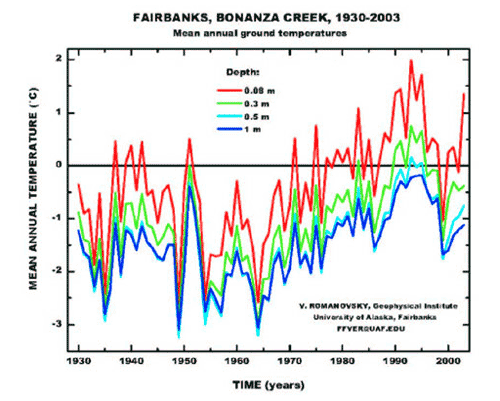 by Doug Schneider June 10, 2004
If you're looking for evidence of a warmer Alaska, the first thing you might notice are the state's rapidly retreating glaciers and thinner sea ice. Such evidence has received a great deal of public attention and captured headlines. But largely unmentioned has been the state's melting permafrost, the one piece of evidence that lies, literally, underfoot. Much of Alaska and the Arctic sits atop frozen ground called permafrost. And scientists say it's melting at an unprecedented rate. It's harder to see and to measure than, say, sea ice. And let's face it, melting dirt isn't nearly as dramatic as a disappearing glacier. And yet, the consequences for Alaska are great, according to Lawson Brigham. He's the deputy executive director of the U.S. Arctic Research Commission.
Lawson Brigham said, "Approximately 100,000 Alaskans live on permafrost, either discontinuous permafrost or continuous permafrost. Those 100,000 people could be directly affected by the change in the active layer of permafrost." About two-thirds of Alaska is covered by permafrost-some of it by continuous permafrost, which at least in theory doesn't thaw in the summertime, and some by discontinuous permafrost, which is ground that thaws a little bit each summer and freezes again in winter. More than a quarter of the Northern Hemisphere is underlain by permafrost. There's also permafrost within the seabed and land margins of the Arctic Ocean. Scientists say the discontinuous permafrost layer beneath Alaska has warmed an average two degrees since the 1960s. That doesn't seem like much, until you consider that the layer is just barely below freezing to begin with. In some areas south of the Yukon River, which Yet while individual researchers are engaged in studies of Arctic permafrost, there's no organized program of permafrost research. In its recent report, the U.S. Arctic Research Commission urged a coordinated program be developed among state and federal agencies. Brigham said, "What we're saying in the report is that today there is no visible coordinated or coherent permafrost program in this country. There have been some world-class and very visible U.S. programs in the past. (But) all of the U.S. programs have lapsed. What the county lacks is a coherent, integrated, multiagency research program on permafrost." Brigham says numerous federal agencies now studying aspects of permafrost should coordinate their activities and raise public awareness. He said agencies such as the U.S. Geological Survey and the National Science Foundation should take a leadership role, but that NASA, with its satellite capability, also should participate. He said a coordinated program would engage engineers studying new materials, and develop new standards for building on permafrost-everything from floating foundations to new ways of building roads. Brigham said, "There's a huge infrastructure around Alaska and the circumpolar world that is built on this part of the cryosphere, built on frozen ground. And if it's all changing, and there's great evidence of fair and rapid change in the active layer of permafrost, then what's going to happen? What are the requirements and how do you adapt to these changes? What are the scenarios of possible futures down the road where greater attention will have to be given from an engineering perspective?"
The story is courtesy of Arctic
Science Journeys, a production of the Alaska Sea Grant Program
at the University of Alaska Fairbanks School of Fisheries and
Ocean Sciences. ASJ news home page is www.asjnews.org.
|
||
